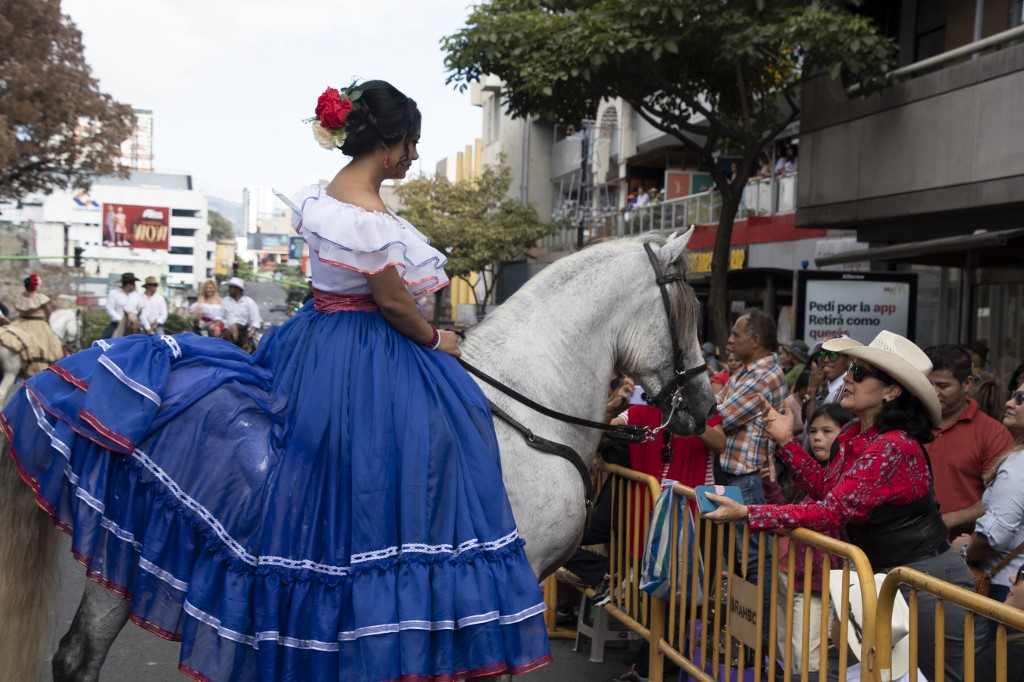Cowboy hats and boots, in the purest “wild west” style, flooded the streets of downtown San José on Monday to proudly show off Costa Rica’s horse culture.
Hundreds of animals and their riders paraded in ‘El Tope’ to commemorate, after three years without showing off due to the coronavirus pandemic, the National Day of the Horseman.
For Omar González, horses are his life. A veterinarian specializing in equines for three decades, at 58 years of age he was designated as the “dedicatee” of the 2022 parade, the person to whom the parade is dedicated each year.
“The horse for Costa Rica is one of the emblems of the people and going out to show off the horse on the day of the national El Tope is a conviviality with friends, it’s going to have a good time in a healthy way,” said Gonzalez.
He has spent his whole life dedicated to raising and healing horses, and has participated in ‘El Tope‘ since he was a child.
Gonzalez has been waiting three years to be able to get back on the back of his horse to parade: “It’s a national celebration,” he says.
Tradition and pride
Since 2019 the horses had not paraded through the streets of downtown San José again. With the return of the horseshoes hitting the asphalt Costa Ricans took to the streets by the thousands to see the equines.
‘El Tope’ commemorates Costa Rica’s equestrian tradition since colonial times, when horses were necessary to move around the country or work in the fields.
From that time comes the figure of the ‘sabanero‘, a Tico-style cowboy, now embodied by the hundreds of riders who join the parade every year.
Marianela Matamoros, 58 years old, waits behind the fences that delimit the route to see the horses go by.
Some riders approach the crowd on the sides so they can pet the animals. Others ride different gaits of the horse, most of them at a walk, or doing paso doble, showing as if the equine were dancing.
“In Costa Rica there are many horses and (‘El Tope‘) is something that the Ticos look forward to because here they come to show off their animals, they come to show what they have of beauty and enjoy, which is the most important thing,” says Matamoros.
The horses were shown with their hairdos and braided manes and tails, shiny saddles and ribbons adorning their hair. The riders, some in traditional costumes and virtually all in assorted boots and hats.
Protecting the horse
Before showing off their finery, the hundreds of animals to be paraded must undergo a veterinary checkup.
Teams from the National Animal Health Service (Senasa) together with groups of veterinarians check each of the horses as soon as they get off the trucks that transport them, even before they are saddled.
Diana Jiménez, 35, is the regent in charge of the veterinary teams and assures that they make sure that the animals “are well prepared, that they have adequate shoes, that they have an adequate body condition, that they have no wounds or signs of diseases that could pose a risk to other participants”.
In addition, the veterinary teams supervise during the ride that no animal suffers, either by accident or by misbehavior of its rider.
“The use of spurs is inappropriate, (also) the abusive use of the whip or correction. Riders in a state of drunkenness are not allowed to participate either,” Jiménez told AFP.
In case of observing any malpractice, they have the power to remove the animal from the parade, sanction the rider or even confiscate the horse.
Despite the veterinary controls, the control and the guarantees given by the organizers on the 4 kilometers of the route, activists rejected the parade.
A dozen people demonstrated with banners that read: “It’s no fun for the horses. ‘El Tope’ is animal exploitation” or “Your fun, their torture”.






